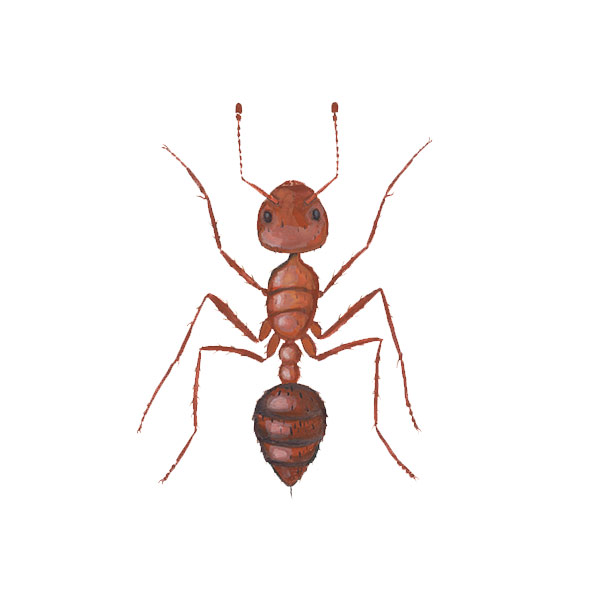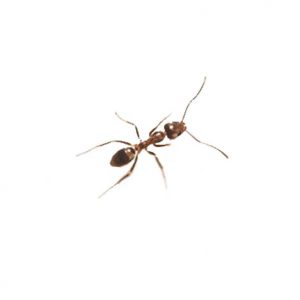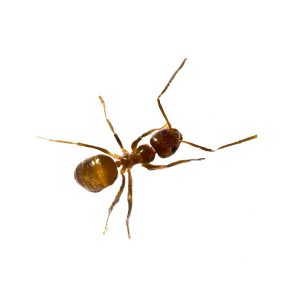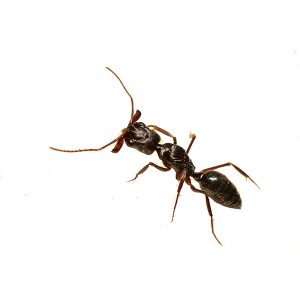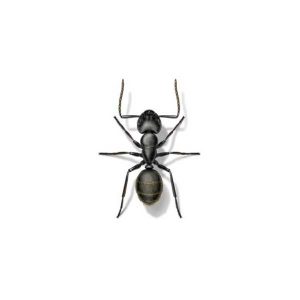Fire Ants in Georgia
Fire ants in Georgia are small yet aggressive insects. These ants live in colonies containing up to 400,000 worker ants. They are notorious for their painful stings, which are delivered by a stinger on their abdomen. The sting is their primary defense mechanism. When a fire ant mound is disturbed, workers quickly emerge from the mound and make their way toward the threat. They use their mandibles to grip the victim and sting in unison. This coordinated attack can be overwhelming, as dozens or even hundreds of ants may sting simultaneously.
What Do Fire Ants Look Like?
Fire ants, scientifically known as Solenopsis invicta, are reddish in color and have darker abdomens. Worker ants are typically 1/16 to 1/4 inch long, while the queen ants can grow larger, up to 1/3 inch. They have a distinctive three-segmented thorax, which distinguishes them from other ant species like odorous house ants or pharaoh ants. The fire ant’s stinger is located on the abdomen, which can be seen under close inspection. These ants can be identified by their aggressive behavior and the painful sting they deliver.
Signs of a Fire Ant Infestation
Recognizing a fire ant infestation early can help prevent further problems. Common signs include:
- Fire ant mounds: Dome-shaped piles of soil that appear in lawns, gardens, or along pathways. These mounds can range in size, but they are typically found in open, sunny areas.
- Swarming ants: Fire ants often form large, visible groups when disturbed or while foraging for food.
- Painful stings: If you or your pets have been stung, it’s a clear indication that fire ants are nearby. These stings typically cause painful, raised welts that can develop into pustules.
- Worker ants: A large number of worker ants foraging around the mound is another sign of an infestation.
Habitat, Diet, Life Cycle & Behaviors
Where Do Fire Ants Live?
Fire ants thrive in warm, moist environments and are commonly found near rivers, streams, well-watered lawns, and other moisture-laden areas. They build distinctive mounds in the soil, often in open, sunny spaces like fields or lawns. These mounds can reach several inches in height and hide extensive underground tunnels. Fire ants prefer disturbed soil, making agricultural fields, parks, and gardens ideal habitats. While some colonies have a single queen, others can be polygynous, with more than one queen, allowing them to establish dense populations in a given area.

Diet
Fire ants are omnivorous, feeding on a variety of food sources. They will eat seeds, small animals, and insects. Their diet also includes sugary substances such as nectar and honeydew from aphids. Worker ants forage in groups and bring food back to the colony, where it is shared with the queen and developing larvae. Fire ants can also scavenge on decaying animal matter, making them opportunistic feeders.
Life Cycle
The life cycle of fire ants consists of four stages: egg, larva, pupa, and adult. The queen fire ant lays hundreds of eggs daily, ensuring a constant supply of new ants. Eggs hatch into larvae, which are fed and cared for by worker ants. The larvae then pupate before emerging as adult ants. Some fire ant colonies are exceptionally large due to their multiple queens, leading to rapid colony growth.
Behaviours
Fire ants are notorious for their aggressive behavior, especially when they feel their nest is threatened. When a mound is disturbed, worker ants swarm to defend the colony and sting in unison. Fire ants use their venomous stings to immobilize their prey and protect their nest. They also demonstrate a rare ability to create floating rafts during floods, allowing them to survive even in extreme conditions. Fire ants communicate through pheromones, coordinating their activities in highly organized groups.
Are Fire Ants Dangerous?
For most people, the sting of a fire ant causes a painful, raised welt and is the primary threat caused by this ant species. Most individuals describe the sensation as feeling like ‘fire,’ hence their name. In more severe cases, fire ant stings can trigger allergic reactions, including swelling, difficulty breathing, and, in rare instances, anaphylaxis, which requires immediate medical attention. Fire ants can also aggressively dominate local or native ant species in the area, disturbing ecosystems and the animals that eat native ant species.
Their ability to quickly establish large colonies makes them particularly harmful to agriculture, as they can damage crops, livestock, and equipment. Fire ants have even been known to chew through electrical wiring, causing costly damage to infrastructure. Fire ants are considered invasive, and up to $5 billion is spent in the U.S. alone on fire ant treatments. This makes them not only a physical and ecological threat but also an economic burden.
If you suspect you have fire ants, it is recommended to contact a licensed ant exterminator. Professional pest control services can efficiently locate and eliminate fire ant colonies, reducing the risk of re-infestation.
How to Get Rid of Fire Ants?
Getting rid of fire ants can be a daunting task, but there are several effective methods to control and eliminate these pests. Bait treatments are among the most reliable solutions for fire ant control. Worker ants collect the bait and carry it back to the colony, where it is shared with the queen and other members. Over time, this method reduces the ant colony, including the queen, ensuring the infestation is eliminated at its source.
For larger or more persistent infestations, seeking the help of a professional ant control is highly recommended. Professional exterminators like Active Pest Control can locate, treat, and monitor fire ant colonies with precision, providing long-term solutions to manage these invasive pests effectively.
Fire Ant Prevention Tips
Preventing a fire ant infestation requires proactive measures to make your property less appealing to these insects. Start by regularly inspecting your lawn for signs of fire ant mounds, particularly in sunny, open areas where they tend to thrive. Early detection can help you address a problem before it becomes a full-blown infestation. You can deter fire ants by reducing excessive moisture and keeping your yard well-groomed.
Additionally, seal any cracks or gaps around windows and doors to prevent fire ants from entering your home. Finally, eliminate potential food sources by storing items in sealed containers and promptly cleaning up crumbs or spills.
Do You Have an Ant Infestation Problem? We Can Help.
Dealing with fire ants or other ant species like Argentine ants, odorous house ants, or pharaoh ants can be challenging. For reliable solutions, contact Active Pest Control. Our expert technicians are equipped to assess your situation, identify the source of the infestation, and implement customized treatment plans to eliminate the problem effectively.
With our proven ant control and prevention strategies, we’ll help ensure your home or business stays safe. Don’t let ants take over—reach out to Active Pest Control for professional support today.
Frequently Asked Questions
Does a fire ant bite or sting?
Fire ants sting; they do not bite. They grab onto their prey with their mandibles and inject venom using their stinger.
Are fire ants poisonous?
Yes, fire ants are venomous. Their stings can cause pain and, in rare cases, cause allergic reactions.
Where are fire ants native to?
Fire ants are originally from South America, specifically Brazil, but they have become invasive in the United States, particularly in southern states like Georgia.
Are all red ants fire ants?
No, not all red ants are fire ants. Other ant species, such as Pogonomyrmex (harvester ants), are also red but behave very differently.
Are fire ants invasive?
Yes, fire ants are invasive and have caused significant ecological and economic damage since they were introduced to the U.S. They outcompete native ant species and cause problems for humans and wildlife.
Need help with pest control?
Ready for your FREE quote?
Fill out the form below and we’ll be in touch!
*During normal business hours. After hours inquiries will be returned the next business day.

